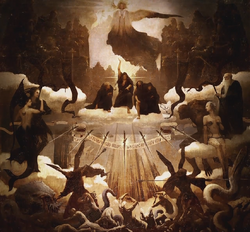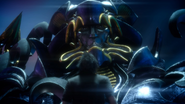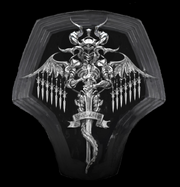Template:Sideicon Template:Summon Bahamut, the Draconian is an astral who appears in Final Fantasy XV. He is one of the Six and a god clad in winged armor. Bahamut appears to be the leader of the astrals, and is said to have bestowed the powers of the Oracle and the kings of Lucis onto mankind.
Profile
Like the other astrals, Bahamut is based on a recurring summon in the Final Fantasy series. Bahamut is is one of the most prominent summons in the Final Fantasy series, and is typically considered the strongest among storyline summons. Bahamut in Final Fantasy XV may pay homage to the Bahamut from the original Final Fantasy, who made but a brief appearance to grant the Warriors of Light their class changes as recognition of their power and bravery.
Bahamut in Final Fantasy XV dons metallic armor similar to that of the traditional Dragoon armor, and is more humanoid in appearance. He has a dragon's tail, and the wings of his armor are made of swords, himself also brandishing one. When he unleashes Ultima Sword his wings disappear as the swords circle around him, but two long red capes with golden markings billow behind him giving him the appearance of flying with wings. He is big enough for Prince Noctis to fit upon the palm of his hand. On the cover of the Cosmogony books , and on the paintings of the prophecy kept in the Citadel in Lucis
, and on the paintings of the prophecy kept in the Citadel in Lucis , Bahamut is depicted as a winged man wearing black armor.
, Bahamut is depicted as a winged man wearing black armor.
The astrals of Eos are associated with a classical element from the Final Fantasy series, although not all of the elements, e.g. Leviathan's water, are represented in Final Fantasy XV as gameplay elements. Whereas the other astrals are linked to "earthly" elements, Bahamut is associated with the power of light or holiness. In the Japanese five elements philosophy, Bahamut could be seen as representing the highest element, 空 Kū or sora, most often translated as "Void", but also meaning "sky" or "Heaven". It represents things beyond people's everyday experience, particularly things composed of pure energy.
Story

Close-up of Bahamut.
Ifrit betrayed the rest of the astrals and started the Starscourge, a plague that turns life forms into daemons and gradually eats away daylight from the world. The other astrals devised a plan to purge it, and according to legend, Bahamut chose two mortals who became the first Lucian king and the first Oracle. The Oracle can commune with the astrals and Bahamut is said to have granted her his trident. The Oracle has the power to heal people of the Starscourge and hold it at bay long enough for Bahamut's long-term plan: the True King. The Lucian king was given the Ring of Lucii, which would absorb the soul and power of each Lucian king that dies, accumulating power with each king's death until the final king would be powerful enough to completely purge the Starscourge.
Bahamut resides within Insomnia's Crystal, a magical stone the kings are sworn to protect until the coming of the True King. On the cover the Cosmogony books, Bahamut is shown as giving the Crystal to a king. As depicted in the Omen trailer, Bahamut appears to talk to King Regis when he stands before the Crystal. Throughout the centuries the Ring of the Lucii has accumulated power from each Lucian king that perishes, and Regis asks the Crystal how many more lives are needed. A voice answers it is "only looking forward to one, and then I can rest".
The King of Kings shall be granted the power to banish the darkness, but the blood price must be paid. Many sacrificed all for the King; so must the King sacrifice himself for all.
Bahamut to Noctis
Regis's son Prince Noctis encounters Bahamut in an otherworldly dimension after he is absorbed into the Crystal. Bahamut explains the Crystal holds the soul of Eos, and the true nature of Ardyn Izunia. The only way to defeat him and cast away the darkness is with the Light the Providence, for which Noctis as the True King must sacrifice himself. Bahamut releases Noctis from his grasp, allowing him to enter a state of hibernation, strengthening himself and giving him time to reflect on his destiny.

Bahamut descends upon Ifrit.
Ten years later at the time of Noctis's reawakening, Bahamut instructs him to return to Insomnia to battle Ardyn and gives Noctis the ability to summon him. In Insomnia, Bahamut appears at the battle against Ifrit. Bahamut rains down swords before descending upon Ifrit himself allowing Noctis to cleave off one of Ifrit's horns, and Bahamut vanishes into the nether.
Bahamut's plan comes into fruition when Noctis and the combined powers of the Lucian kings erase Ardyn's spirit. The Ring of the Lucii disintegrates, but both of the bloodlines Bahamut had blessed have been extinguished.
Obtained
The player obtains Bahamut as a summon at the end of game's thirteenth chapter.
Battle
Unlike the other astrals, Bahamut can only be called during the Ifrit boss encounter. When summoned, Bahamut uses Ultima Sword, an attack that causes several massive blades to rain down on Ifrit.
Gallery
Etymology
Bahamut (Arabic بهموت Bahamūt) originated as an enormous whale in ancient pre-Islamic Arabian mythology. Upon Bahamut's back stands a bull with four thousand eyes, ears, noses, mouths, tongues and feet called Kujuta (also spelled "Kuyutha") (compared with the pair of Behemoth and Leviathan). Between each of these is a distance of a 500-year journey. On the back of Kujuta is a mountain of ruby. Atop this mountain is an angel who carries six hells, earth, and seven heavens on its shoulders.
Another version of the Arabic story is that Bahamut is indeed a dragon and he stands on a whale called Liwash.
In modern times, the game Dungeons & Dragons is responsible for reimagining Bahamut as the king of dragons, a benevolent Platinum Dragon; the opposite of the malevolent Tiamat, the five-headed Chromatic Queen of Dragons.
Bahamut's attack in Final Fantasy XV is Ultima Sword. Ultima means "the last" in Latin and many Latin-based languages. The word is an inflection of ultimus which is the superlative of ulter, which means "that is beyond". In the Spanish versions of many Final Fantasy games, the spell Ultima's name is written as "Artema", a close transliteration of the Japanese katakana.
Trivia

Kingsglaive symbol.
- Bahamut appears to be on the symbol for the Kingsglaive. In the insignia also appear fifteen swords, likely an allusion to Final Fantasy XV. The paper model for his wing (see the Gallery) used for designing his character model, also comprises of fifteen swords.
- Bahamut is associated with multiple swords, his wings being literally made out of them and his summon attack being Ultima Sword that has massive blades rain down on the enemy. Lucian kings' ability to wield multiple weapons at once with Armiger could thus be a power originating from Bahamut, although not all of the royal arms are swords. Bahamut is the astral of light, and the royal arms embody this element.
- Bahamut may be related to Angelgard, the island off the coast of Galdin Quay that has Bahamut's colossal swords stuck to the ground around a prison. The island's shape could be that of wings. Many astrals, such as Titan with the Disc of Cauthess, are associated with a specific location on Eos.
Template:FFXV




